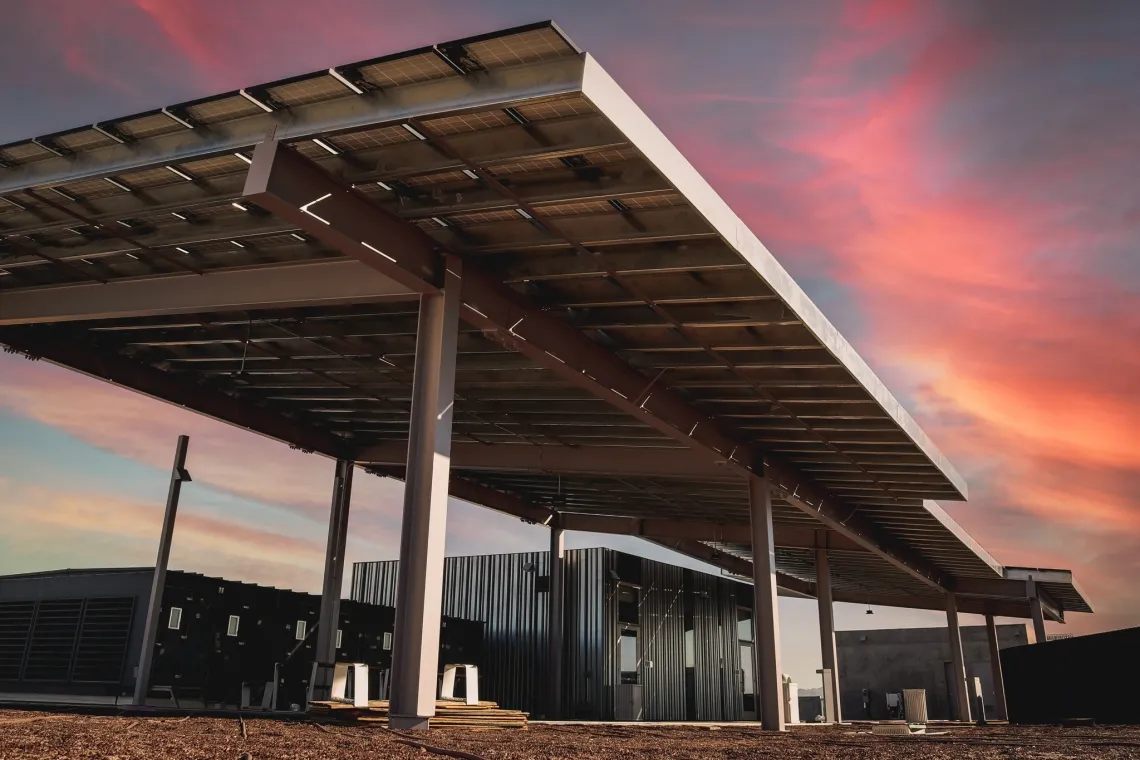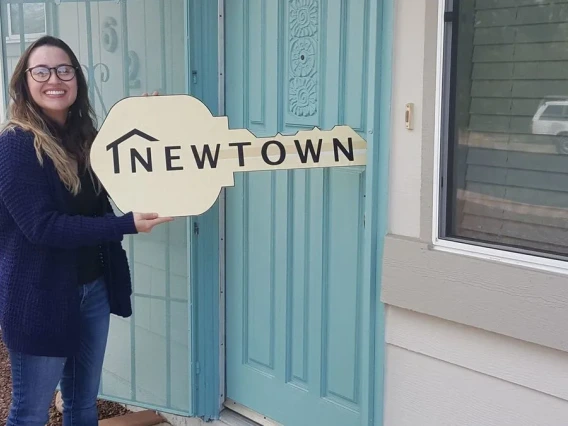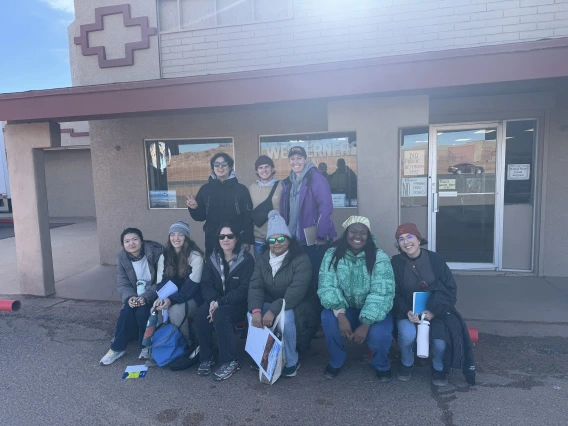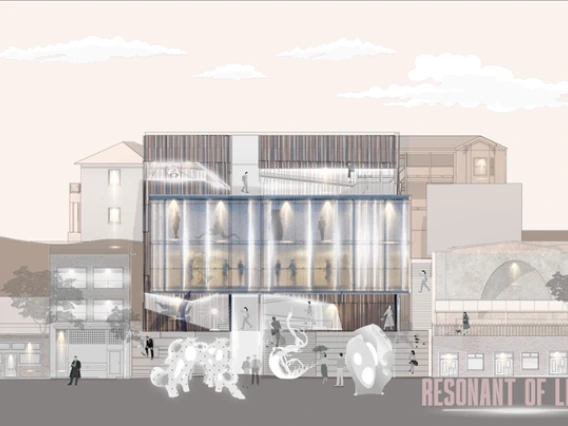Harvesting Sunlight and Plant Power on UArizona's Greenest Building

288 solar panels were installed atop ENR2 and will provide 15% of the building's annual electrical use. The panels also partially shade a green roof where scientists will study the benefits of combining solar panels with green spaces. Photo by Kevin Choi.
Construction of a rooftop garden and solar panels atop the University of Arizona's Environment and Natural Resources 2, or ENR2, building is complete, and the research phase of the ENR2 Rooftop PV+ Project can now begin.
The method of growing crops under solar panels to increase the efficiency of both is called agrivoltaics—a semantic mashup of "agriculture" and "photovoltaics." When any other kind of plant is used, such as native species instead of crops, the system is called photovoltaic-plus, or PV+.
ENR2 is already a LEED Platinum-certified building, the highest rating in the Leadership in Energy and Environmental Design rating program. The Rooftop PV+ Project is a way to demonstrate sustainability in the desert while also providing unique research and learning opportunities for the UArizona community.
Planting the Seeds
"In 2012, representatives from the city of Tucson came to us wondering if solar arrays contributed to Tucson's heat island effect—which occurs when heat is trapped and then re-emitted at night by a built environment, making it hotter than surrounding natural areas," said Greg Barron-Gafford, an associate professor in the School of Geography, Development and the Environment and research team lead on the rooftop. "We found that it did."
A self-proclaimed "plant person," Barron-Gafford had a solution. Typically, when solar panels are installed, vegetation is scraped away.
"But then I thought, when plants open their pores to let carbon dioxide in, water escapes. If we put vegetation back in, would the evaporation of water cool the panels down?" Barron-Gafford said.
His first tests were done at Biosphere 2, where he worked with UArizona undergraduates to plant lawn and native grasses underneath solar panels.
"The grass was really greener under the solar panels," Barron-Gafford said.
Typical solar panels perform best at temperatures cooler than 77 degrees Fahrenheit, but Tucson temperatures regularly exceed that threshold, especially in direct sunlight. Water released by plants beneath the panels cool the panels by as much as 20 degrees, Barron-Gafford found, increasing their efficiency and electrical output. At the same time, shade from the panels helped prevent water loss in extreme heat, increasing plant productivity by as much as 300%. Agrivoltaic systems that evaluate crop performance have since been installed at Rincon/University High School and Manzo Elementary School in Tucson.
"Agrivoltaics is a big area of interest, not only here where we get a whole lot of sun and heat while also serving as an agricultural hub, but also in Europe where the colocation of these systems can reduce land-use pressures," said Trevor Ledbetter, who is the director of the university's Office of Sustainability and has been overseeing construction of the green roof. "The combination of these systems has the potential to improve sustainability on a large scale, resulting in a 60% increase in land-use efficiency."
Research teams led by Barron-Gafford and Assistant Professor of Landscape Architecture Kirk Dimond and Professor of Landscape Architecture Margaret Livingston will plant native desert species in the rooftop garden.
"These plants will not only supply ecosystem services for pollinators such as bees, birds and bugs, but in doing so, support local agriculture," Dimond said. As the plants grow, the team will examine the differences between agrivoltaic gardening and plant growth away from solar panels.
Panels Donated by TEP
ENR2 was designed and built with the ability to host a green roof and solar panels. In 2017, Students for Sustainability took up the task.
"They pulled together a group of staff and faculty and a few other students to start envisioning what it might look like to put a system like this on the top of ENR2," Ledbetter said.
In fall 2018, the Office of Sustainability secured $500,000 from the Division of Business Affairs and $10,000 from the Institute of the Environment—now the Arizona Institutes for Resilience: Solutions for the Environment and Society—to support Phase I: green roof installation. Phase I construction began in November 2019 and ended in January 2020.
Tucson Electric Power donated the solar panels for Phase II: panel installation, as part of the university's Large-Scale Renewable Energy Agreement, a partnership that aims to reduce the university's greenhouse gas emissions by a third. The university invested an additional $270,000 for the steel supports, paid for by accumulated energy rebates from TEP.
Phase II began in November 2020 and ended last month. Phase III, research, begins this spring.
Roof Can Serve as an Outdoor Classroom
To create the green roof, 95 bags of soil weighing 3,000 pounds each were hoisted onto the northern half of ENR2's roof using a crane. Ultimately, 285,000 pounds of soil filled in 5,200 square feet of sunken planters.
The rooftop garden will be divided into 20 study plots, with half of the plots having a five-inch planting depth and half having an eight-inch planting depth. Five plots of each depth will be located beneath the solar panels and five of each will have open sky exposure so that the plots can be compared.
A total of 288 solar panels were installed over portions of the green roof. The panels are 18.5 feet off the ground at their highest point and 12.6 feet at the lowest point. Of the 288 panels, 276 of them generate power. The 12 nonfunctional panels help complete the canopy but are unable to produce electricity. The installation will provide 15% of the electricity used by ENR2 annually.
Students will be hired to maintain the project site, to program sensors, to collect and process data and more, Dimond said.
Infrared cameras will monitor surface temperatures, while sensors in and around the planters will collect environmental data such as air temperature in shade and sun, as well as soil temperature and moisture levels to understand how water moves through the system. The team also hopes to monitor soil characteristics and determine the solar panels' impacts on plant biology, pollinators and the building itself.
This spring, the team will begin planting native wildflowers and shrubs at the site.
"It's usually a challenge to get different disciplines to work in the same place to answer a question, but by having this project on top of the building that supports the School of Geography, Development and the Environment and the School of Natural Resources and the Environment, which is across the street from the Department of Ecology and Evolutionary Biology and down the street from the School of Plant Sciences and the College of Engineering, means that all these disparate groups can more easily host a project together," Barron-Gafford said.
The green roof also can serve as an experimental learning site for classrooms.
"We'll have plots marked off using landscaping material so that people know not to walk over or mess with the planters. Otherwise, students can walk around the perimeter," he said. "The doors are way more open for experiential learning than other places in the county."
Learn More
To learn more about the Rooftop PV+ Project, visit https://sustainability.arizona.edu/projects/enr2-rooftop-photovoltaic-pv-project.
To get involved with the research or start conducting your own research, visit https://app.smartsheet.com/b/form/1ea7747f9fe541438a92a514ef7df15f.
To see a live rooftop view, visit http://150.135.6.130/index.html?size=2&mode=0.



